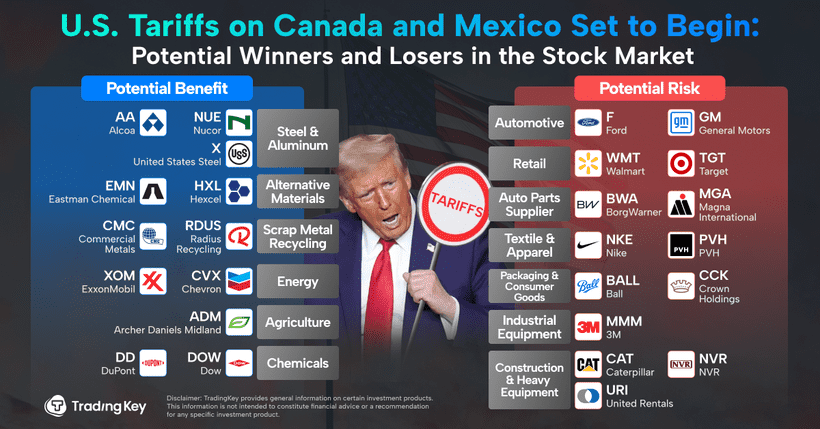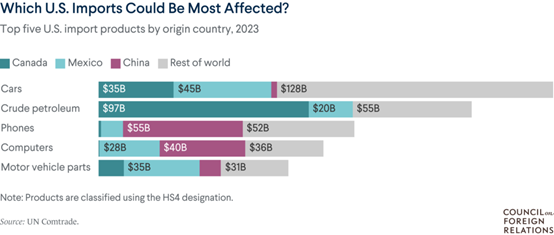U.S. Tariffs on Canada and Mexico Set to Begin: Potential Winners and Losers in the US Stock Market

TradingKey - US President Donald Trump confirmed on Monday that the planned tariffs on imports from Mexico and Canada will take effect as scheduled, following the expiration of a 30-day suspension. These duties were initially delayed after Mexico and Canada pledged to strengthen border security, but they are set to be implemented on March 4.
On February 1, Trump signed an executive order imposing a 25% tariff on imports from Mexico and Canada. A lower 10% tariff applies specifically to Canadian energy.
Meanwhile, Trump has mandated a 25% tariff on all steel and aluminum imports. Canada and Mexico are among the largest suppliers of these metals to the US.
White House stated that these new tariffs will take effect on March 12 and will extend beyond raw materials to hundreds of steel and aluminum-based products, such as electrical conduits and industrial machinery components.
Economists widely warn that these tariffs will likely raise costs for American importers, leading to higher prices for essential goods, including groceries and gasoline, which could further fuel inflation. However, Trump administration argues that the tariffs are part of a broader economic strategy, which includes tax cuts and expanded domestic energy production, aimed at offsetting cost increases and supporting overall economic stability.

Source: Bloomberg
Lessons from the 2018 Tariffs
During Trump's first term, tax cuts spurred job growth in the US manufacturing sector. However, after the tariffs on steel and aluminum were introduced in 2018—alongside the trade war with China—US manufacturing activity declined.
By 2019, the first full year following the initial steel and aluminum tariffs, industrial output declined, and the sector lost jobs as businesses struggled with higher costs.
Unlike the 2018 tariffs, which primarily targeted raw steel and aluminum, the new tariffs extend to processed products, such as extrusions and slabs, which play a key role in manufacturing industries, including automotive production, construction, and industrial equipment.
Another key concern is the impact on financial markets. In 2018, the tariffs contributed to a stock market selloff, as higher import costs reduced corporate profit margins, weighing on investor sentiment.
Source: WOLFSTREET.COM
Impact on the US Steel and Aluminum Market
Steel prices have surged in the US recently. According to Fastmarkets, Midwest hot-rolled coil prices increased by 12% in just two weeks, reaching $839 per short ton—representing a 20% rise since January 20, the day of Trump’s inauguration. However, similar steel prices in Europe have risen by only 6%, while prices in China have remained largely stable.
A report from Goldman Sachs warns that without exemptions for major trade partners, the cost burden will be passed on to US businesses and consumers.
Rising costs are already affecting American manufacturers and contractors who rely on imported metals. According to a survey by S&P Global, input prices for manufacturers surged in February, and industry leaders are increasingly concerned about the inflationary effects of tariffs.
Manufacturers and construction firms are voicing concerns over higher material costs. While US steel producers may benefit in the short term from these policies, businesses that rely on steel and aluminum—such as automakers, appliance manufacturers, and construction firms—will face higher operating costs, potentially leading to price hikes for consumers.
The National Association of Home Builders (NAHB) has warned that these tariffs will directly undermine Trump’s efforts to lower housing costs and expand supply.
“His move to impose 25% tariffs on all steel and aluminum products imports into the US runs totally counter to this goal by raising home building costs, deterring new development and frustrating efforts to rebuild in the wake of natural disasters,” NAHB Chairman Carl Harris said in an emailed statement.
Broad Economic Impact
Critical US industries, including automotive manufacturing and energy production, are poised for significant strain under proposed trade measures. Canada and Mexico, which collectively supply over 70% of crude oil imports to US refineries, could face retaliatory tariffs that risk spiking Midwest gasoline prices by $0.50 per gallon, directly impacting consumer costs and regional energy security.
The automotive sector, deeply integrated with North American supply chains, is particularly vulnerable. Nearly 50% of automotive components used in US vehicle assembly are sourced from these two neighboring nations. A 25% tariff on imports from Canada and Mexico would elevate production costs for domestic automakers, potentially raising the price of new vehicles by $3,000 in a market with annual sales of approximately 16 million units.
Since Mexico is the largest supplier of fresh produce to the US, accounting for over 60% of US vegetable imports and nearly half of fruit and nut imports, grocery costs may also rise.

Source: The Council on Foreign Relations
Potential Upcoming Tariff Policies
President Trump has hinted at additional tariffs across key industries, including autos, lumber, semiconductors, and pharmaceuticals, which could be officially announced as early as April 2.
Trump has long criticized the European Union's 10% tariff on imported vehicles, compared to the lower 2.5% rate applied by the US to imported passenger cars. However, it's worth noting that the US already imposes a steep 25% tariff on foreign pickup trucks, a measure that has been beneficial to Detroit-based automakers.
During Trump's first term, the US Commerce Department launched a national security investigation into foreign automobile imports, concluding that imports undermined the domestic industrial base. Although Trump threatened to impose 25% tariffs on foreign vehicles in 2018 and 2019, no tariffs were ultimately enacted. However, these previous reports could now be revisited and revised to justify new trade measures.
Moreover, the US Department of Commerce has initiated an administrative review of Canadian softwood lumber tariffs, covering the period from January 1, 2024, to December 31, 2024. This review will examine whether Canadian exporters have absorbed anti-dumping and countervailing duties through affiliated US importers. The results of this investigation could impact tariff rates and influence Canada-US trade policy moving forward.
Here Are the Stocks to Watch
Steel & Aluminum – Nucor (NUE): Largest U.S. steel producer.
Alternative Materials – Hexcel (HXL): Specializes in carbon fiber and composites as metal alternatives.
Scrap Metal Recycling – Commercial Metals (CMC): Engages in scrap steel recycling.
Energy – ExxonMobil (XOM): Major U.S. refining and chemicals company.
Agriculture – Archer Daniels Midland (ADM): Key player in the domestic agriculture market.
Chemicals – Dow (DOW): Leading U.S.-based chemical producer.
Automotive – Ford (F): A major domestic automaker.
Retail – Walmart (WMT): Relies heavily on imported goods.
Auto Parts Supplier – BorgWarner (BWA): Dependent on imported components.
Textile & Apparel – Nike (NKE): Depends on imported textiles and apparel.
Packaging & Consumer Goods – Ball (BALL): Produces aluminum cans.
Industrial Equipment – 3M (MMM): Manufactures materials that rely on specialty steel.
Construction & Heavy Equipment – Caterpillar (CAT): Produces equipment that relies on steel.








